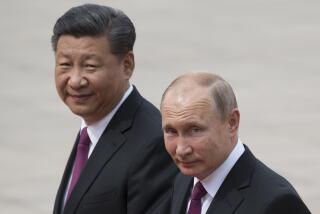Disquiet returns to China-India relations
Reporting from New Delhi —
The India-China relationship, relatively well managed for years by the two governments, is under growing pressure in the face of insensitivity and nationalism on both sides, India’s hyperactive broadcast media and the growing autonomy of Chinese ministries, analysts say.
Irritants that have spurred distrust recently between the two Asian giants include a series of reported incursions along their disputed 2,500-mile border.
In one case, an Indian warship off Vietnam received an apparent Chinese naval radio transmission in July telling it to “leave Chinese waters.” In another situation that upset India, an official Chinese brochure used at a November news conference in New Delhi announcing a $400-million investment by a Chinese state-owned heavy equipment manufacturer featured a map that included as part of China the Indian state of Arunachal Pradesh and sections of Kashmir claimed by India.
The two neighbors are among the world’s fastest-growing economies, but Chinese planning, infrastructure and foreign-investment flows have seen it outpace India on the global business stage.
“A closer look at the incidents suggests the Indian press made more of them than were there,” Pramit Pal Chaudhuri, strategic affairs editor with the Hindustan Times newspaper, said at the Common Agenda Round Table conference in Shanghai in early December. “But they’ve strongly contributed to greater suspicion by the Indian public.”
Many people in India were annoyed by Beijing’s policy a few years ago to issue Chinese visas separate from passports for Indians living in Kashmir. Divided Kashmir is claimed by both India and Pakistan, and each side maintains its area of control. The visa policy, since reversed, offended many Indians, suggesting that Indian-controlled Kashmir was not an integral part of their country.
India, in something of a tit for tat, allowed the Dalai Lama in 2009 to travel to a monastery near the Chinese border. Beijing deeply distrusts the exiled Tibetan spiritual leader — who escaped from China in 1959 and now lives in northern India — blaming him for the recent self-immolations by protesting monks and other unrest in Tibet and other regions. India’s not-so-subtle message: If you start questioning our Kashmir claims, we’ll do the same with your Tibet claims.
Late last month, China pulled out of joint border talks because the Dalai Lama was speaking at a conference in New Delhi that week.
“Differences have to be managed very carefully,” said Sujit Dutta, professor at Delhi’s Jamia Millia Islamia University. “We need to find a basic understanding.”
Although few see the two giants going to war, mutual mistrust can lead to missteps, analysts said.
The China-India border may be the second-most dangerous frontier in Asia after the demilitarized zone separating North and South Korea, John Pomfret, a journalist and author of “Chinese Lessons,” said at the Shanghai conference. In 1962, India and China fought a brief war in which India was trounced.
“India is the only country defeated by Communist China in a war; they might be tempted to do it again,” Pomfret said. “The Indians also might easily be lured by populist anti-China fever to do the same.”
Recent India-China misunderstandings have been compounded, Pomfret and other analysts said, by the growing autonomy of Chinese ministries. Where once they voiced a single party line, increasingly they espouse contradictory positions, making it more difficult to read Chinese intentions.
Many of the problems China and India face are similar, including corruption, rapid urbanization and the challenge of feeding hundreds of millions of poor citizens, but their institutions and approach are often very different, said Rukmani Gupta, a research fellow at India’s Institute of Peace and Conflict Studies.
India’s bid to stem corruption, for example, has been driven by massive public demonstrations and the legislature, Gupta said, while China’s involves Communist Party policing even as it works hard to prevent protest gatherings.
Zhu Huanian, deputy editor with the Shanghai Daily newspaper, said the rise of social media represents a challenge for governments increasingly finding themselves second-guessed on policy. Nationalist bloggers in China are often particularly excitable about border and territorial disputes, other analysts said.
Until a few years ago China ranked near the top of foreign nations in Indian public opinion surveys, but that’s slipped significantly, said the Hindustan Times’ Chaudhuri, who is part of a grouping of academics, journalists and think tank analysts looking at India-China relations.
This is partially because of India’s broadcast media, he said, which tends to sensationalize issues. Indian military officials suggest privately, for instance, that patrols from both countries routinely cross the India-China border given the rough, unmarked terrain.
But China’s clunky public relations hasn’t helped, Chaudhuri said. China’s ambassador to India, Zhang Yan, told an Indian journalist to “shut up” during the investment news conference last month when challenged on why the Chinese brochure map mischaracterized the border.
Sometimes worse, Chaudhuri said, is that Chinese officials often won’t comment when there are problems, providing an opportunity for Indian hawks to paint China in the worst light, further fueling public distrust.
More to Read
Sign up for Essential California
The most important California stories and recommendations in your inbox every morning.
You may occasionally receive promotional content from the Los Angeles Times.










